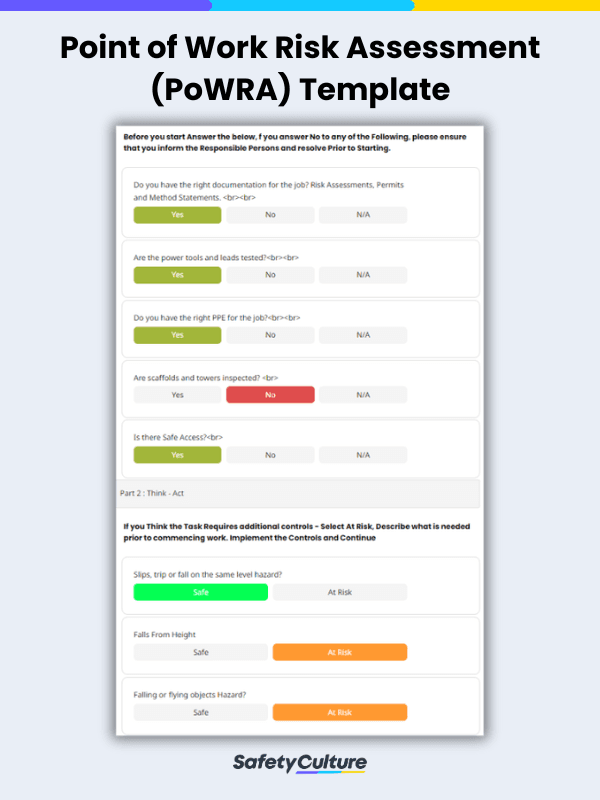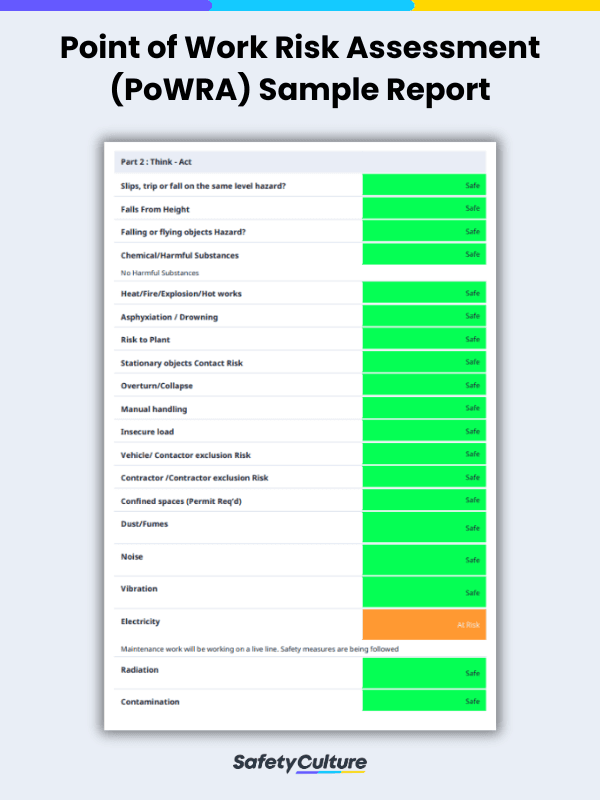What is a Point of Work Risk Assessment (POWRA) Template?
A Point of Work Risk Assessment (POWRA) template is a tool used to assess risks before starting any task or maintenance activity, particularly in industries like refrigeration, air conditioning, and heat pump systems. It’s usually completed by the individuals performing the work at the specific location where the work will be done.
Importance and Benefits
Using the template helps identify potential hazards, evaluate risks, and determine necessary precautions to ensure safety. This procedure offers various benefits in ensuring workplace safety and compliance with regulations, including the following:
- Workplace Protection – Regular use of a checklist fosters a safety-conscious culture where employees are more aware of risks and take proactive steps to protect themselves and others.
- Legal Compliance – Maintaining risk assessment records demonstrates a commitment to safety compliance. It also aids in providing evidence of due diligence in case of audits or inspections.
- Cost Efficiency – Costly repairs or replacements due to accidents can be avoided, leading to long-term cost savings and efficient resource management.
- Continuous Improvement – Feedback from inspections and checks can be used to update safety procedures and equipment to enhance safety measures.
What to Include in a Point of Work Risk Assessment Template
POWRA templates may vary depending on the nature of work and where the audit will take place. However, there are several key components that should essentially be included in a POWRA template to ensure comprehensive evaluation, such as the following:
- Task Description – Clearly define the task or job to be performed, including details such as the nature of the work, location, equipment involved, and personnel responsible.
- Hazard Identification – Identify potential hazards associated with the task, workplace, equipment, or environment where the work will be conducted. Consider factors like falls from height, confined spaces, poor lighting, chemicals, noise, manual handling, and other relevant risks.
- Risk Assessment – Evaluate the identified hazards to determine the level of risk they pose to workers, equipment, and the environment. Classify risks as high, medium, or low based on the likelihood and severity of potential incidents.
- Control Measures/Response – Outline steps to be taken to ensure the safety of workers, such as providing personal protective equipment, implementing safe work practices, or conducting training.
- Monitoring and Review – Summarize the audit, identify any lessons learned, and make recommendations for future tasks. Add actions points and assign them to responsible personnel.
How to Conduct a Point of Work Risk Assessment with a Checklist
Using a digital checklist allows you to answer crucial safety areas before starting your work and add more context to your findings. Here’s a step-by-step guide on how to use a checklist for this type of risk assessment:
- Start by filling in the basic details of the work, such as the people involved and the location of the work.
- Upload necessary documents such as permits, method statements, and/or risk assessments.
- Check on preparedness for the task by overseeing Personal Protective Equipment (PPE), tools, and safe access in the workplace.
- Conduct a venue check and look for potential hazards, including falls from height, falling objects, electricity, weather hazards, etc.
- Summarize the check by adding notes and learnings. Add suggestions if needed.
Frequently Asked Questions (FAQs)
POWRAs should be completed by the people who will be doing the work and in the place where the work will be done. This ensures that those directly involved in the task are actively engaged in assessing risks, identifying hazards, and implementing necessary safety measures to maintain a secure work environment.
Point of work risk assessments should be conducted at the start of each shift or whenever circumstances change significantly.
In a point of work risk assessment, the types of hazards considered typically include electrical hazards such as electric shock, burns, overloaded circuits, damaged tools and equipment, power lines, and wet conditions. These hazards are crucial to evaluate to ensure a safe work environment and prevent accidents.
Yes, point of work risk assessments can help improve productivity by reducing downtime related to safety issues. This outlines all necessary safety precautions before starting the task rather than conducting a safety check on multiple occasions.




